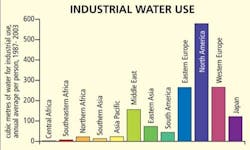Power Play over Power Plant Effluent
CARLOS DAVID MOGOLLON, MANAGING EDITOR
Just in time for our Power-Gen International preview issue, the U.S. Environmental Protection Agency kicks out two new items sure to keep the industry talking through December. That’s good since the PennWell event is Dec. 8-10 in Las Vegas (see product preview, p. 37).
The first item involves a move to revise effluent guidelines for steam electric power generating facilities, i.e., coal-fired plants, announced Sept. 15. It’s based on a multi-year study of power plant wastewater discharges the agency completed earlier this year and published in August, noting current regulations – issued in 1982 – haven’t kept pace with changes in the industry over three decades. Many toxic pollutants discharged from these power plants come from coal ash ponds (see related story, p. 14) and FGD systems used to scrub sulfur dioxide from air emissions.
Figure 1. Territory size shows the proportion of all water for industrial purposes used there, 1987 to 2003.
The second involves a judicial ruling in July in Riverkeeper Inc. v. EPA, in response to which the agency suspended cooling water intake structure regulations – under Phase II Rule - CWA §316(b) promulgated in 2004 – for existing large power plants due to the 2nd Circuit Court of Appeals decision. This really just formalizes an EPA move in March 2007 due to earlier action in the case, according to a memo from former EPA Assistant Administrator Ben Grumbles that instructs regulators to use their “best professional judgment” regarding related permits for all Phase II facilities. In fact, that same memo is posted with the July announcement on the EPA Cooling Water Intake Structures webpage. So, it’s really back to status quo until a new proposal is presented.
Figure 2. . Industrial water use in cubic meters, annual average per person, 1987-2003 – on average 665 billion m³/year, or twice that for domestic use.
It should be noted the power industry uses some 80 trillion gallons of water a year to cool equipment, or about four times the water in the Chesapeake Bay – which former Waterkeeper Alliance president Steve Fleischli points out at HuffingtonPost.com in a Sept. 12 column entitled: “Power Plants Don’t Have to Suck (Literally)”. That’s not to say Fleischli wants us to go back to the dark ages. Instead, he and Riverkeeper have been arguing power plants should be required to employ closed-cycle cooling loops and advanced intake systems that recirculate water and would reduce fish mortality by 95% – instead of older once-through cooling water systems. He adds the California State Water Resources Control Board is considering mandating phase-out of such “antiquated” once-through technology. But, bear in mind, Riverkeeper lost in an effort to force this through last fall in Entergy Corp. v. Riverkeeper Inc., et al., in which it was considered too limiting of “best technology” choices.
Still, as illustrated in a map and bar chart on this page from www.worldmapper.org, North America is by far the largest consumer of water for industrial use worldwide – with China rapidly gaining ground. And with the largest U.S. cooling water user, NJ’s Salem Nuclear Plant, drawing over 3 billion gallons a day and killing an estimated 845 million fish in Delaware Bay a year, it’s easy to see how a little progress on the topic could make a significant positive impact on the environment, climate change – and water industry professionals specializing in this area of expertise.


